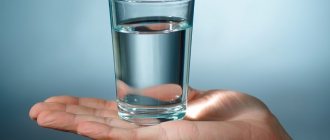Last to leave, first to arrive
Everyone has problem areas in their body - both professional bodybuilders and just people who train. Yes, yes, you know what I'm talking about: those stubborn, annoying folds in the lower abdomen.
The fat in these areas appears immediately after you stop your diet and is always the last to go when you are on the path to building a better version of yourself. Let's talk about how to remove fat from problem areas, but first let's figure out why it so stubbornly doesn't want to leave some places?
The nature of fat in problem areas
It would seem that fat is fat, but this is not entirely true. There are different types of fat tissue in the body, and they respond differently to your lifestyle, exercise, and diet.
There is brown adipose tissue, the “good” fat that helps your body generate heat and is even known to help you burn more calories. Visceral fat surrounds the organs in the abdominal cavity, while intermuscular fat accumulates in and around muscle fibers.
When we talk about stubborn fat, we most often mean subcutaneous fat. Such fat has a higher density of alpha receptors, it is more sensitive to insulin and has a worse blood supply compared to fat that is lost quickly.
When fat is burned, including stubborn fat, hormone-sensitive lipase is activated by hormones, breaking down triglycerides into glycerol and fatty acids. Next, fatty acids are oxidized under the influence of oxygen, and breakdown products are excreted through sweat, urine, feces, and even through respiration.
Fat in problem areas essentially burns at a slower pace than other types. The reason lies in such physically active substances as catecholamines. The task of these substances is to bind to receptors (alpha and beta receptors) in adipose tissue, which in turn affects the rate of fat burning. Beta receptors promote fat burning, and alpha receptors promote fat storage.
In other words, alpha receptors, which are responsible for storing fat, slow down the action of hormone-dependent lipase, which is the main enzyme in the body responsible for breaking down fat.
So in order to burn fat, you need to increase the number of beta receptors and decrease the number of alpha receptors. There are several ways to do this: improving blood flow and insulin sensitivity will help activate beta receptors to help burn fat in the lower abdomen and those problem areas. What needs to be done for this will be described in this article.
Cream or soap: how to properly care for the skin in intimate places?
- Use only special cosmetics for delicate intimate care. It contains natural ingredients, does not cause allergic reactions and is suitable for gentle cleansing of delicate areas. The composition of GINOCOMFORT washing gels corresponds to modern recommendations of gynecologists - GINOCOMFORT intimate cosmetics are not only suitable for daily care, but also help to maintain the cleanliness of the genitals during menstruation and during the treatment of gynecological diseases, when the body is especially vulnerable.
- If possible, wear comfortable underwear made from natural fabrics. If you want to wear erotic panties, be sure to take a shower before putting on such panties, and also change your underwear before going to bed - sleeping in thongs can increase the level of pathogenic bacteria in the vagina.
- Maintain personal hygiene: obstetricians-gynecologists recommend washing yourself 1-2 times a day, during menstruation up to 4 times a day, if possible, with each pad change.
Pads and tampons should be changed every 3-4 hours, regardless of the amount of discharge. - Pay attention to contraception: if you are allergic to latex, choose condoms made from other materials.
- Visit your obstetrician-gynecologist at least 2 times a year to rule out the development of diseases.
And remember: irritation in the intimate area, even if it just “itches” and there are no other more serious symptoms, is not the norm, and this condition is most often easy to eliminate.
There is no need to avoid the possibility of solving an unpleasant problem. The right cosmetics and treatment selected by an obstetrician-gynecologist will allow you to regain confidence in your beauty, comfort, feeling of freshness and good mood every day. Sources:
- Inflammatory diseases of the female genital organs. Modern perinatal technologies in strengthening the reproductive health of patients. Naumov I.A. // Monograph. Saarbrucken: LAP LAMBERT Academic Publishing GmbH end Co. KG. — 2011. — pp. 18–21.
- Microbiological characteristics of biotopes of the reproductive tract with endometritis. Glukhova E.V., Shakhovskaya I.N. // Togliatti honey. consultation – 2008. – 1 (2): pp. 38–44.
- Medical and social characteristics and forecasting of reproductive health of young women at the present stage. Torubarov S.F. // Social aspects of public health. – 2013. – 5 (33): P. 7.
- https://ciplamed.com/content/important-tips-to-maintain-intimate-hygiene
- https://www.lactacyd.eu/your-intimate-zone/
- https://www.medicalnewstoday.com/articles/321537.php
Method 1: Train on an empty stomach
Fasting is abstaining from consuming any calorie-containing foods for a short period of time. Working out on an empty stomach is the most effective way to get rid of stubborn fat from different areas of the body.
I'm not talking about abstaining from food for a day and I'm not encouraging you to torture yourself with hunger. The idea is to not eat for 16-18 hours and then eat for the remaining 8-10 hours. This is a proven method that allows you to transfer fat cells into the metabolic furnace, where they will be utilized. How does it work?
Fasting makes it easier to achieve a calorie deficit
Intermittent fasting allows busy people to maintain a calorie deficit. There are other benefits of fasting, but 80% of the benefits of fasting are in its impact on lifestyle: if you consume fewer calories than you expend and do so consistently, you will burn more fat.
Fasting may increase growth hormone production
The production of growth hormone is the most important factor influencing muscle growth and fat burning. The decrease in growth hormone production with age is the reason why fat burning slows down. There is evidence that fasting increases the production of growth hormone, and therefore accelerates fat burning.
Fasting increases insulin sensitivity
Insulin sensitivity, or lack thereof, plays a critical role in fat storage. Although most of the research on intermittent fasting has focused on diabetics, the findings can be applied to healthy people as well. A 2005 study led by Halberg et al found that intermittent fasting improved insulin sensitivity in healthy people.
Fasting helps control appetite
I would, however, not recommend training on an empty stomach if you want to maintain muscle while losing weight or building muscle, fighting stubborn fat in problem areas is a war of attrition.
The use of training on an empty stomach is justified in two cases:
First, according to Gzhested's research, blood flow to problem areas such as the lower abdomen improves during fasting. When blood supply increases, catecholamines can attack fat cells, activate them and burn fat faster.
Second, based on personal preference, fasted training is a double whammy for fat loss, especially when combined with cardio. For most iron enthusiasts, doing cardio to burn fat can improve fat oxidation simply because we rarely do cardio. If you want to be extremely lean (7% and below), then fasted cardio is what can help you.
One drawback is that muscle catabolism may increase with the fasted training method. For this reason, keep this trump card in your pocket and only play it when you are already quite dry and want to achieve extreme relief. Do not use this method if your main goal is muscle growth.
Pimples and irritation after shaving in the intimate area in women: how to properly remove hair with a razor?
Hair removal in intimate areas is a recent trend. How to avoid irritation after depilation?
- Be sure to apply shaving cream or foam to your skin before depilation.
- If you are removing hair with a reusable machine, treat it with a disinfectant such as alcohol or chlorhexidine.
- Use only a very sharp razor; a dull razor can damage delicate skin.
- Do not press the razor too tightly against the skin or run over one area several times in a row.
- After depilation, treat the skin with a septic cream and do not wear underwear until it dries to allow the area to calm down and not cause irritation.
Method 2: Specialized nutrition
No supplement can independently turn on fat burning mode. First, you should build a diet and exercise routine. But I would be lying if I said that supplements are not an important factor in eliminating problem areas. You need three factors - training (flame), caloric deficit (fuel), and nutritional supplements will serve as the ignition spark, accelerating the combustion process.
The best way to get more beta receptors through specialized nutrition is to use supplements or eat foods that will increase the amount of fat-burning hormones that bind to beta receptors.
Here's what you should use for this:
- Capsaicin. Capsaicin is the ingredient in chili peppers that gives them their heat. It increases fat burning by accelerating metabolic processes and increasing the level of fat-burning hormones.
- Yohimbine. Yohimbine and products containing it improve fat burning by neutralizing alpha receptors in adipose tissue. If you combine training, fasting and taking foods with yohimbine, fat burning, especially in problem areas, will accelerate.
- Green tea extract. Drinking green tea has a similar effect. Green tea has a thermogenic effect, which has an effect on fat burning.
- Caffeine. Your morning cup of coffee can work wonders if the coffee is really strong. Caffeine binds to fat cells and accelerates lipolysis.
- Conjugated linoleic acid (CLA), which inhibits lipoprotein lipase, an enzyme responsible for fat storage. As a result of consuming CLA, fat tissue becomes better available for use instead of being stored. In addition, CLA has powerful anti-inflammatory effects, improving joint and overall health during the diet.
Causes of irritation in the bikini area
- External factors
Irritation in the bikini area is often caused by mechanical damage to the skin. After shaving the intimate area, redness, pimples, and itching often appear - the skin becomes especially inflamed in the summer, when sweating increases. When depilating with a razor, the top layer of skin is damaged, which can lead to dryness and flaking, and growing short hairs cause itching and, accordingly, redness and scratches on the skin.
Expert opinion
Depilation using wax, sugar paste and tweezers damages the top layer of skin to a lesser extent, but more often provokes ingrown hairs. As a result, painful pimples form in the bikini area, the opening of which is fraught with the penetration of pathogenic agents into the deeper layers of the skin (especially in the hot season).
Obstetrician-gynecologist of the highest category Oksana Anatolyevna Gartleb
Violation of the temperature regime that is comfortable for the skin - too high or, conversely, low temperature - can also cause discomfort in the vagina. Of course, external contamination of delicate areas may not be the last cause of irritation.
In addition, discomfort may occur from inappropriate intimate cosmetics. For example, hypoallergenic baby soap, which many women still use as an intimate care product, greatly dries out the delicate skin of the vagina, since the production of sebum by baby skin and the delicate skin of the intimate area occurs in different volumes. It is important to use special products for intimate hygiene - for example, GINOCOMFORT Soothing washing gel consists of natural ingredients that not only delicately cleanse the vaginal mucosa and skin of the labia, but also regulate the acid-base balance that is comfortable for this area.
- Microflora disturbance
One of the most common causes of severe irritation in the intimate area is diseases associated with disruption of the natural bacterial and acid-base balance: thrush (candidiasis), bacterial vaginosis (dysbacteriosis).
These diseases can be caused by a general decrease in immunity, poor diet, sleep, hygiene, frequent stress, taking antibiotics, promiscuity, etc.
Characteristic symptoms include severe irritation in the intimate area after sex, thick atypical discharge with a pronounced unpleasant odor, severe itching and burning. Any of these diseases is treated with special regimens using antibacterial drugs, pro and prebiotics. Self-medication can cause irreversible complications or make the process critical, so it is better to contact an obstetrician-gynecologist to clarify the diagnosis and develop treatment tactics.
- Allergic reactions
Often, intimate itching can occur with contact dermatitis - a manifestation of allergies in a delicate area. One of the most common reasons is scented hygiene products. Fragrance in pads, tampons, and toilet paper is a strong allergen and can cause itching. If you experience irritation in your intimate area, especially during menstruation, try changing your pads - this may solve your problem. In some cases, allergies can be caused by contraception (latex condoms) and lubricants. Most condoms are made from latex.
- Hormonal background
Irritation in the intimate area in women often occurs before hormonal changes: menstruation, pregnancy. Many women are familiar with the sensation of dryness, burning, and severe itching. Irritation in the perineum can be an external sign of hormonal disorders such as hypo- or hyperfunction of the thyroid gland, ovaries, and adrenal glands. To establish an accurate diagnosis, a consultation with an obstetrician-gynecologist and tests for hormone levels are necessary.
Expert opinion
Changes in hormonal levels and the resulting irritation in the intimate area can be triggered by taking oral contraceptives. This situation is especially common if a woman takes OCs, chosen independently or on the advice of a friend, without consulting a gynecologist.
Obstetrician-gynecologist of the highest category Oksana Anatolyevna Gartleb
- Poor intimate hygiene
It is obvious that irregular showering, especially during menstruation, hot weather or after visiting the gym, leads to an increased proliferation of harmful bacteria and fungi, causing rashes and itching in the intimate area in women. Wearing synthetic underwear also has a negative effect - panties made of artificial fabrics do not allow air to pass through, creating a greenhouse effect - an ideal environment for the proliferation of pathogenic microbes. It is important to know that thongs, thongs and similar models are a “bridge” for bacteria from the anus, so if discomfort occurs, it is better to refrain from wearing them.
- Diseases of internal organs
Endocrinologists warn: severe itching and dryness in the genital area is one of the indirect signs of diabetes. Sometimes irritation in the intimate area can indicate anemia, leukemia, immunodeficiency conditions, inflammation in the urinary system, gastrointestinal tract, and cancer. Redness, spots and rashes on the external genitalia occur with eczema (eczematis) and psoriasis (psoriasis).
Of course, you can’t rely only on vaginal itching to make an accurate diagnosis, but this unpleasant symptom can indicate serious health problems, so it’s better not to delay visiting a specialist.
- Sexual infections
Itching, burning and unpleasant discharge after sexual intercourse (especially unprotected with a new man) are accompanying sexually transmitted diseases. They are especially characteristic of gonorrhea (Gonorrhoea), chlamydia and trichomoniasis (trichomoniasis). In addition to discomfort in the intimate area, sharp pain during urination, pain during sexual intercourse and foul-smelling discharge may be added - if these signs appear, you should urgently get tested and visit an obstetrician-gynecologist. Most sexually transmitted infections in the early stages can be quickly and successfully treated, so timely consultation with a doctor can save you from unpleasant consequences and complications.
- Stress
The female genital organs are very susceptible to psychological conditions: emotional instability, stress and frequent anxiety can cause itching in intimate places.
It is important to monitor your stress levels whenever possible and use sedative therapy if necessary to improve your quality of life.
The causes of irritation in intimate areas are varied and may depend on completely different factors. If you feel that self-treatment does not lead to an improvement in the situation, do not hesitate to visit an obstetrician-gynecologist, this way you will quickly determine the cause of the discomfort and get rid of it.
The causes of irritation in intimate areas are varied and may depend on completely different factors. If you feel that home treatment does not lead to an improvement in the situation, do not hesitate to visit a gynecologist, this way you will quickly determine the cause of the discomfort and get rid of it.
Method 3: Training aimed at activating fat burning
Even though every trainer on the planet seems to be talking about this, I’ll say it again: you can speed up fat loss in problem areas. How to do this?
To begin with, you need to be fairly thin already, otherwise you won't see a difference. You create a calorie deficit and perform special workouts that activate blood circulation in problem areas.
This is exactly how it works: you improve blood flow to stubborn areas, increase catecholamine activity and ensure the breakdown of fat molecules. Through training, fat is utilized.
How to achieve this? There is a formula: alternate exercises that warm up your problem areas for 45-60 seconds (for example, abdominal exercises) with high-intensity exercises, such as sprinting for 30-45 seconds.
How to get rid of skin irritation in the intimate area?
Of course, only an obstetrician-gynecologist can determine the exact treatment regimen depending on the cause of discomfort. We will tell you about the main methods of relieving itching and burning in intimate areas. In cases associated with diseases of the reproductive organs and other internal diseases, when discomfort in the vagina is a concomitant symptom, complex drug therapy is used to eliminate the underlying cause. It is prescribed individually depending on the underlying disease. In case of endocrine disorders, treatment is carried out using systemic and local hormonal drugs.
Burning and itching due to disturbances in the acid-base balance and microflora are removed with antibacterial or antiseptic drugs, pro and prebiotics, and lactic acid. Treatment often lasts only a few days.
If the discomfort is mild and does not require serious treatment, daily washing with infusions of calendula, arnica, chamomile and other medicinal plants with a calming and disinfecting effect can help.
In the process of eliminating unpleasant sensations in the vagina, it would not be superfluous to enhance the effect of drug treatment from the outside with the help of specialized intimate cosmetics. Soothing washing gel GINOCOMFORT normalizes microflora, gently cleanses the skin and gives a feeling of freshness throughout the day.
How to properly shave the intimate area for women? Source – Ksyu Myakonkaya – Beauty Ksu
Method 4: Find the best diet for you
When it comes to fat loss, the formula for success is very simple:
Calories burned > calories eaten = fat burned
Fat burning requires following this formula. You must burn more calories than you consume each day in order to see quick results. A calorie deficit created through exercise, diet, and healthy hormone levels will cause fat to burn and get you into good physical shape.
A more precise formula may be too complicated, so to calculate your daily calorie consumption, you can use a simple calculation:
Body weight (in kg) x 33 = your daily calorie intake
This formula is not perfect, but its results are pretty close to more complex ones, and it also gives a good starting value on which to start.
Let's say you weigh 90 kg, therefore:
90 kg. x 33 ≈ 3000 kcal.
This value shows how many calories you need to consume to meet your current needs.
Now let's move on to the more entertaining part: counting the number of calories needed in order to lose weight:
Reducing fat levels in problem areas requires an aggressive approach. 20 - 30% is a suitable value. A 2015 study led by Houvinen determined that trained male athletes can successfully lose weight without significantly reducing testosterone production or reducing performance when maintaining a 25% caloric deficit. Start with a 20% caloric deficit, track your progress and increase this to 30% if you reach a plateau.
Let's say you want to achieve a calorie deficit of 20%, therefore, you need to multiply your daily calorie intake by 0.8. 3000 x 0.8 = 2400 kcal.
Popular questions
Irritation on the pubic area under the hair.
What to do? You need to understand what caused this: an allergic reaction, a bacterial, fungal or viral infection, or an injury during depilation. For this, a consultation with an obstetrician-gynecologist, and in some cases a dermatologist, is required. Only then will it be possible to recommend suitable treatment.
Severe itching on the labia, irritation. There is nothing to worry about in the vagina itself. What could it be?
This may result in an allergic reaction or inflammation. I recommend using Ginocomfort gel with mallow extract, applying it once a day to the discomfort zone for 7 days. If you do not notice relief, consult a doctor.
I am 69 years old. I am concerned about vaginal irritation and dryness. I was treated once with Triozhinal suppositories. The result was positive for 1.5 years. Now this problem has arisen again. But now these candles cause a strong burning sensation. Today I am flying to the sea, and I am afraid that I will not be able to swim, since the salt water is making the problem worse. Please advise what I can do. Thank you! Hello! During the postmenopausal period, inflammatory processes develop in the genital tract against the background of atrophic changes in the mucosa caused by hormone deficiency. Its layers become thinner, elasticity decreases, and the number of lactobacilli decreases. In this situation, a study is required: a smear for flora, oncocytology. The first step is to prescribe drugs with anti-inflammatory activity, and the second step is to moisturize, restore microflora, and, in the absence of contraindications, local hormone-containing suppositories. A feature of treatment in this age group is continuous maintenance therapy. At this stage, before receiving the results of the study, you can use Ginocomfort gel with mallow extract, which will have anti-inflammatory and moisturizing effects. The gel is applied in 1 dose 1 time per day for 10-14 days.
Hello! Is it possible to feel a burning sensation and irritation when using Gynocomfort?
Hello!
A slight tingling sensation may be felt immediately after administration, but will quickly subside on its own. If this happens, then you should continue to use the gel. For an accurate diagnosis, contact a specialist
Macronutrient content
Our diet, based on 2400 kcal per day, should consist of:
- 35% protein
- 35% carbohydrates
- 30% fat
Let's calculate the amount of each macronutrient based on percentage values:
- 35% protein would be 210 grams. 2400 kcal x 0.35 = 840 kcal. In order to determine how much this will be in grams, you need to divide this value by 4 (since one gram of protein contains 4 kcal). Thus we get a value of 210 g. protein per day.
- 35% carbohydrates will also be 210 g. Here's the calculation: 2400 kcal x 0.35 = 840 kcal. A gram of carbohydrates contains 4 kcal, therefore, divide 840 by 4 and get 210 grams. carbohydrates.
- 30% fat would be 80 grams. Calculation: 2400 kcal x 0.30 = 720 kcal. Divide this value by 9 (one gram of fat contains 9 kcal) and we get 80 grams of fat per day.
It's more important to stick to the correct calorie and protein intake than it is to stick to the exact carbohydrate and fat intake. The amount of carbohydrates can be adjusted based on personal preference.
Summarize:
- 2400 kcal. per day;
- 210 gr. squirrel;
- 210 gr. carbohydrates;
- 80 gr. fat










